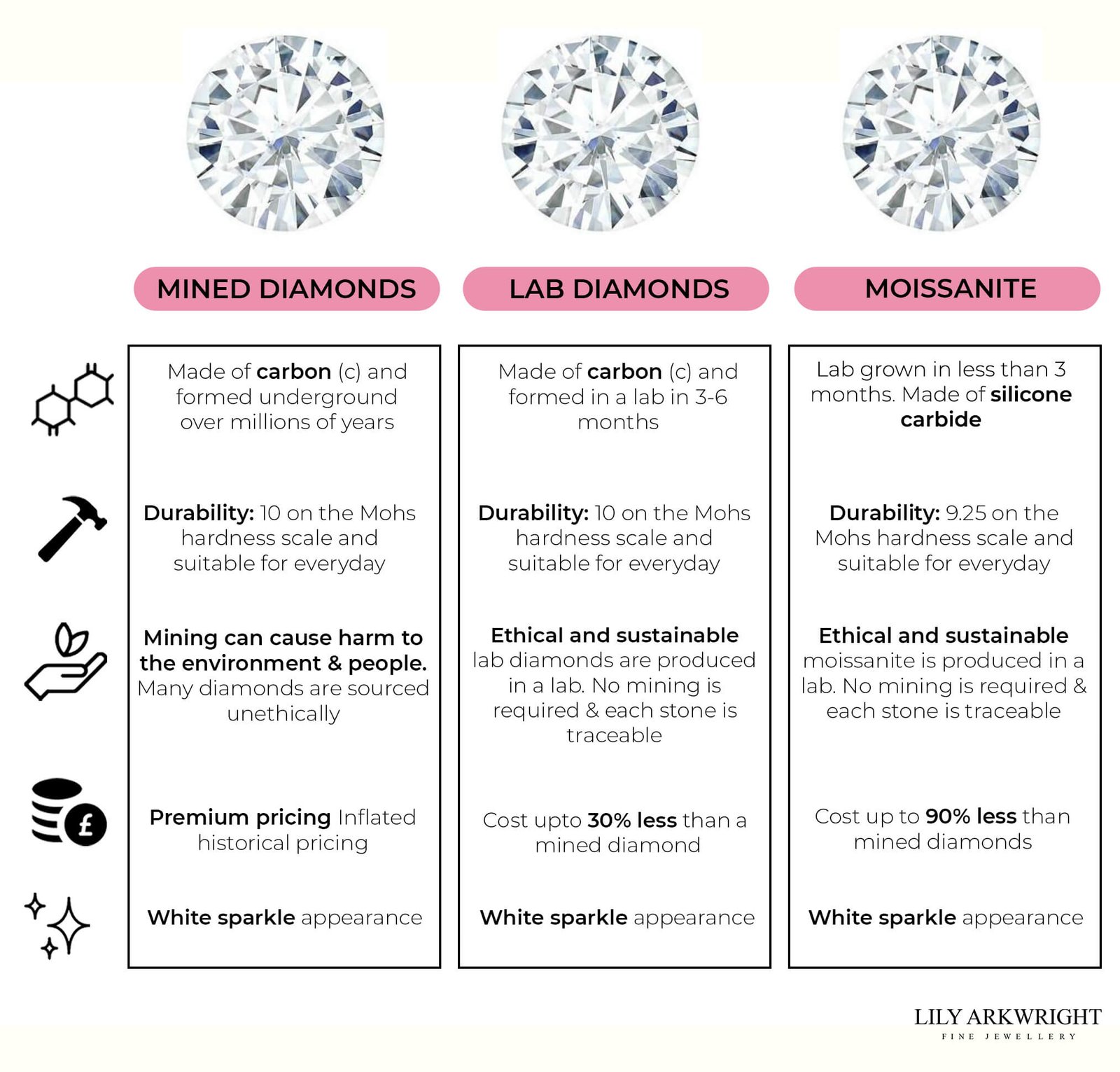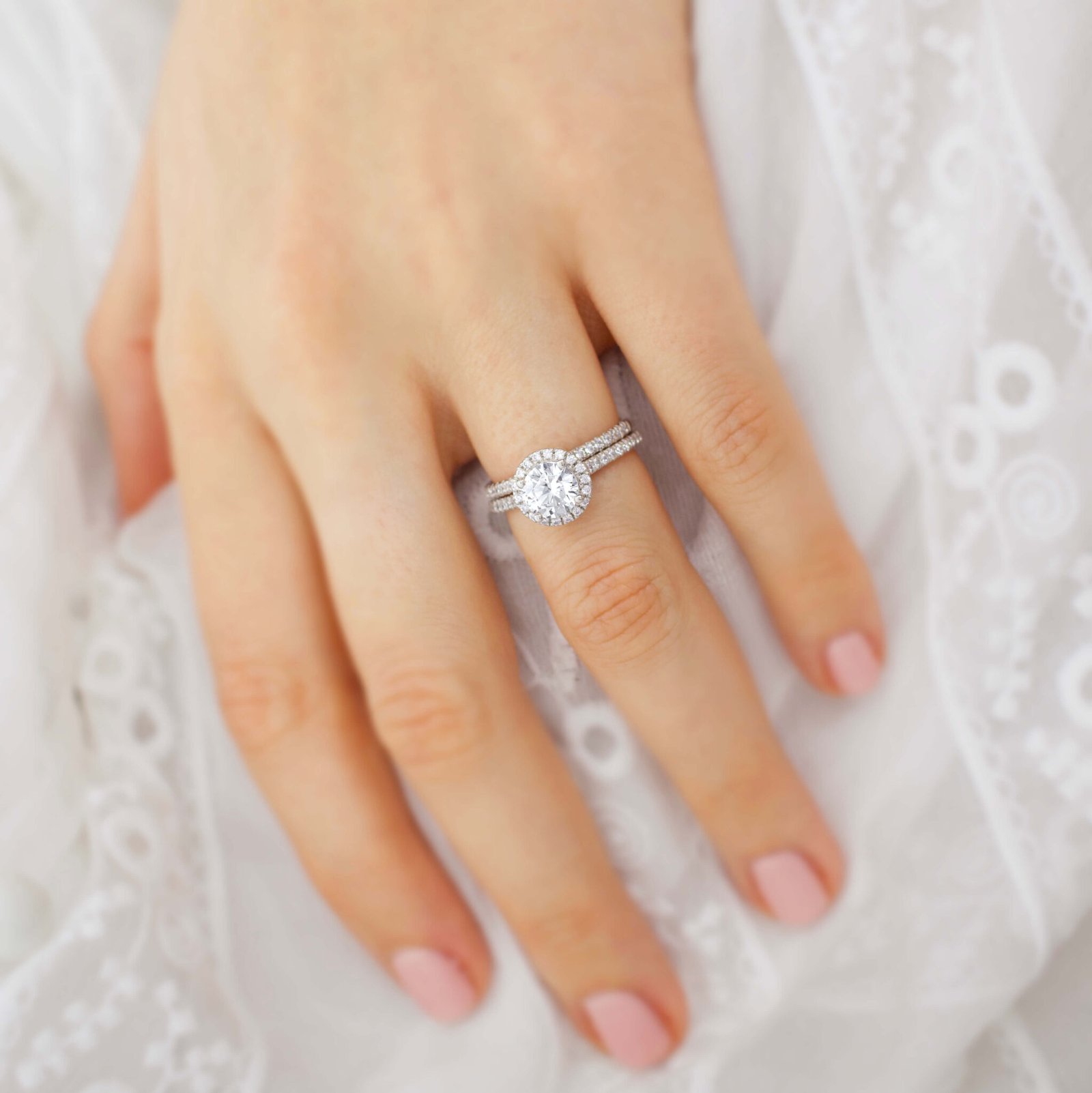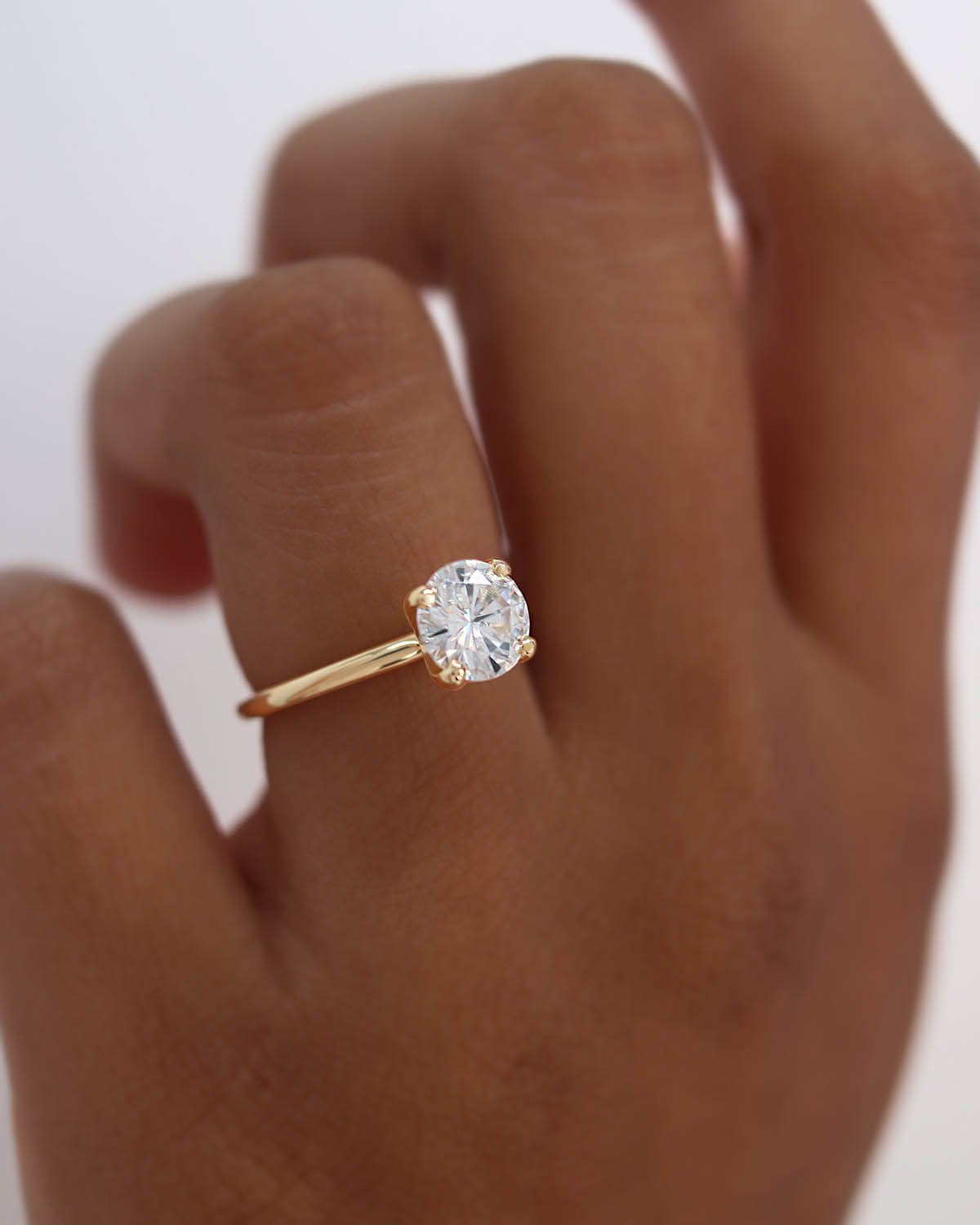Budget Engagement Rings: The Ultimate Guide to Lab Diamond Rings
Engagement rings have always been viewed as an expense that should never be skimped on, but there are a variety of options available for those who are conscious of their budget. Lab diamond engagement rings are the perfect ring alternative for those seeking a more affordable and sustainable option. When opting for lab diamond rings it means that dreaming big can be a reality for a fraction of the price. The lab-grown jewellery experts at Lily Arkwright have collaborated with me today to provide their professional guidance in the form of an ultimate guide into the world of lab grown diamond engagement rings.
Budget Friendly Engagement Rings: The Ultimate Guide to Lab Diamond Rings
One of the most considerable benefits of opting for a lab grown diamond is the affordable price point! The price difference between mined and lab diamonds will vary depending on the quality and the size of the stone but generally, lab grown diamonds cost around 30% less than their mined counterparts. The reasoning for this is due to a smaller production chain, when growing diamonds in a lab there are fewer people involved in the production process. Opting for a lab-grown diamond engagement ring is perfect for someone who’d love a bigger stone for a more affordable price point. Thus, meaning you can spend on other things in future. The social and environmental credentials that lab-grown diamonds behold are particularly notable too!
You might be sitting here wondering exactly how lab diamonds are made? Lily Arkwright work with various world-class laboratories with the most cutting edge technology to produce the highest quality lab grown diamonds. Every lab-diamond sold by Lily Arkwright is fully certified and accompanied by the industry standard GIA, IGA and GCAL grading report which overviews the 4 c’s of diamond specifications: cut, clarity, colour and carat weight. The process of how these diamonds are made simulated the natural process of how mined
diamonds are formed. However the difference being, one is formed by a natural reaction within the earth’s crust and the other under controlled conditions in a science laboratory. The Diamond Foundry has an excellent video explaining the production process of lab-grown diamonds.
How are lab diamonds grown?
Without getting too scientific, there are two primary methods of producing lab grown diamonds which replicate the natural diamond creation process:
HPHT – HPHT which stands for High Pressure High Temperature is a process that was originally developed for industrial purposes in the 1950’s. Like the name suggests, the HPHT process is used to replicate the natural temperatures and pressures found within the earth’s crust and mantle causing natural diamonds to form. A diamond seed is added to a piece of carbon, the carbon is then pressured to over one million pounds per square inch and heated to temperatures in excess of 1,400 degrees celsius. The carbon begins to form around the diamond seed which is then cooled. The HPHT process recreates this natural environment but results in a lab diamond forming within a matter of weeks, rather than an average of 150 million years!
CVD – The other type of diamond creation process is called CVD (Chemical Vapour Deposition) which is a more modern technique whereby diamonds are grown from a hydrocarbon gas mixture. Similar to HPHT, a small diamond seed is placed inside a sealed chamber, this is heated in excess of 700 degrees celsius and mixed with carbon gases. Through ionisation, plasma is formed resulting in carbon and a new diamond then, heat treatments can then be used to enhance the diamond’s colour if required.
At Lily Arkwright they sell both CVD and HPHT diamonds as both methods equally produce exceptional results of high quality lab grown diamonds. The most important factor to consider is the diamond certification that accompanies the lab-grown diamond, which ensures the highest quality inspections and grading of the diamond have been carried out. All of Lily Arkwright’s lab-grown diamonds are certified and accompanied by an International Gemological Institute (IGI), Gem Certificate and Assurance Labs (GCAL) or the most prestigious, a Gemological Institute of America (GIA) certificate.
Have you ever considered where your jewellery has been sourced from? Most of the time the supply chain of diamonds tends to be inaccessible. However, at Lily Arkwright, they are proud Assay Assured retailers, meaning they can always guarantee that all of their jewellery meets and exceeds legal requirements having been independently tested, thus providing outstanding quality jewellery to their customers.
Whilst not all mined diamonds are exploitive to environments and communities, opting for a lab grown diamond, dispels any concerns that might be associated with natural diamond mining. When diamonds are grown in a lab, the unsustainable and unethical mining practices are eliminated, which is another reason for popularity in lab-grown gem engagement rings. Consumers in today’s climate are becoming more aware of the ramifications their purchases can have on the environment and the communities across the globe. Hence why, more people are opting for moissanite and lab-grown diamonds as a green choice whilst still carrying the same luxurious brilliance and fire associated with naturally mined diamonds!
As discussed earlier, another huge benefit that lab grown diamonds have over traditionally mined diamonds is that they are far less expensive to purchase. Having a mined diamond is almost always synonymous with what’s regarded as a traditional engagement ring, this shouldn’t always be the case since there are countless options for every type of newlywed. If
diamonds aren’t quite within your budget then the gorgeous gemstone moissanite is a perfect option for those price savvy couples.
Moissanite is a rare and precious gemstone made of silicon carbide that works as a beautiful alternative to the traditionally mined diamond. Coming in at around 90% cheaper than a natural diamond engagement ring, moissanite provides you with the same fire and brilliance with a budget friendly price tag. Moissanite should be viewed as its own gorgeous gemstone as it possesses its own gorgeous properties, with a higher refractive index than a diamond, meaning moissanite can offer you some serious sparkle for your money! Lab diamonds can offer couples the same hard wearing and equally beautiful option that is both aspirational and achievable. Lab grown diamond costs more than moissanite but still much less than mined diamond, making it another amazing choice. It is also worth noting that all payments with Lily Arkwright made through our global partners PayPal and Klarna are available with 0% interest.
As there are no chemical and visual differences between lab diamonds and mined diamonds, therefore the quality is an exceptional standard of UK fine jewellery. Both lab and mined diamonds share the same score of 10 on the Mohs scale of hardness which measures the scratch resistance of minerals. This is because lab and mined diamonds share the same chemical compositions and the differences cannot be seen by the naked eye.
Moissanite – A lab diamond alternative
Although this is a guide to lab diamond rings it’s also worth mentioning an appreciation for the second hardest gemstone, moissanite. It is also a beautiful gem and considered as one of the best diamond alternatives, with similar exceptional brilliance, fire and sparkle. A unique gem with original chemical and optical properties, moissanite was originally formed in meteorites so is extremely rare in nature.
How is moissanite made?
Moissanite, is often referred to as the gemstone of the stars because of its cosmological origins. The scientist Henri Moissan, discovered an innovative thermal growing process that takes place under controlled laboratory conditions. He originally thought he had discovered diamonds during the discovery of the meteorite crater but later determined that the crystal formations consisted of silicon carbide atoms. Through these years of research, scientists have enabled moissanite formation for use for engagement rings and other fine jewellery. Now, nearly all moissanite stones are lab grown under these strict lab conditions.
Bright and reflective, moissanite is an amazing diamond alternative with a stunning visual appearance, perfect for newlyweds who desire an eco-friendly option and unprecedented shimmer and sparkle at an amazing price point. Moissanite rates second of all gemstones in terms of hardness, scoring ever so slightly lower than diamonds at 9.25-9.5 on the Mohs Scale, making it incredibly durable and a brilliant choice for engagement rings which are designed to be worn every day.
Moissanite and diamonds are very similar to look at and almost impossible to tell apart when compared side by side, however, contrary to popular belief moissanite is not a diamond substitute and should be considered its own gemstone with its own unique optical properties. It has a distinctive fiery sparkle due to it being more refractive than diamond. The refractive index of a material refers to the speed at which light can travel through it, and moissanite’s chemical structure means that it can slow down and bend the light entering it much better than other minerals, making it give off a slight rainbow-like effect. Moissanite is a wonderful alternative as a colourless stone, and due to its optical properties displays a remarkable brilliance.
If you are budget conscious or simply want a beautiful bigger rock for your money, moissanite is perfect as it equates to roughly 90% cheaper than your conventional mined diamond. Additionally, in comparison to mined diamonds, the same size moissanite stone is dramatically lower in cost and this price can fluctuate depending on size, cut and quality.

What rings can I save the most money on?
If you are considering a moissanite engagement ring, there are a variety of beautiful settings for you to choose from. A dazzling halo setting is the perfect way to accommodate your budget as you can opt for a smaller centre stone yet still have a great impact, volume and coverage! A halo setting is a centre stone that is encircled in a pavé of smaller gems clustered together, often diamonds to create a glimmering effect. A halo setting can make your centre stone appear bigger (up to one and a half carats larger in some cases!) and you can then save more money on your centre stone. The halo setting also works perfectly with a lab diamond centre stone and is perfect for those seeking an eco-friendly and affordable gemstone with no mining involved.

A simple solitaire setting is considered the epitome of traditional and classic engagement ring styles. Solitaire rings are far less costly than intricate designs due to their minimal
details and simplistic nature of design, the solitaire allows your centre stone centre stage to sparkle. The plain metal band creates versatility when it comes to choosing a centre stone shape and style, whether that’s a weighty carat weight or something more modest a solitaire setting is perfect for that budget-savvy person looking to save cash to spend on wedding and bridesmaids dresses. Lily Arkwright offers various affordable engagement ring styles options such as the beautiful Lulu. The Lulu solitaire comes in the entire range of gemstone cuts and metal types, from a 18k rose gold radiant cut, to a platinum princess cut. Lily Arkwright works with global partners PayPal and Klarna, to make payments as easy as possible, starting from a 0% interest rate.

Shopping online for your desired ring style is another way to gather great savings on your engagement ring. As Lily Arkwright mainly functions as an online retailer, all of their rings are priced competitively which means customers can expect beautiful moissanite and lab grown diamond engagement rings of the highest quality and an affordable price. Buying online is a
popular and completely safe choice as Lily Arkwrights are proud members of the leading jewellery trade association, the National Association of Jewellers; a professional membership body made up of thousands of UK jewellery traders that have a strict compliance policy. As well as being Assay Assured retailers, assuring all legal standards of assaying and hallmarking have been met.
Final thoughts on lab diamonds, moissanite and natural alternatives.
Lily Arkwright is the ideal place for searching for a lab diamond or moissanite engagement ring. You can have complete confidence and trust in Lily Arkwright to deliver ethically sourced and exceptional quality jewellery, with honesty and integrity. Their expert jewellery consultancy team will guide you through the process of buying an engagement ring online, all supported by unrivalled customer service.
If the idea of lab diamond or moissanite jewellery has sparked your interest or you would like to find out more information about Lily Arkwright and their lab diamond collections simply call them on: 0161 537 6773, or alternatively you can email their jewellery consultancy team at: hello@lilyarkwright.com or book an in-person consultation.
Disclosure: This article is for entertainment and educational purposes only. I am not a financial advisor and you should always do your own research and consult a qualified financial advisor before making big decisions with your money as capital may be at risk. This article may contain affiliate links that generate funds for the site.

